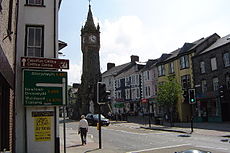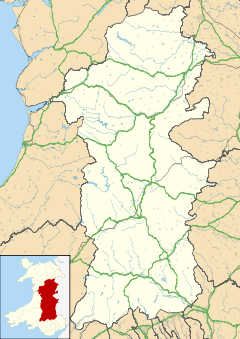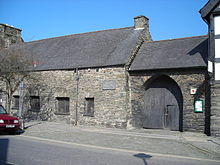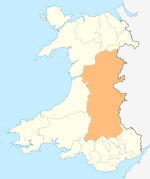- Machynlleth
-
Coordinates: 52°35′27″N 3°50′56″W / 52.59087°N 3.84887°W
Machynlleth 
The Clock Tower
 Machynlleth shown within Powys
Machynlleth shown within PowysPopulation 2,147 [1] OS grid reference SH745005 Principal area Powys Ceremonial county Powys Country Wales Sovereign state United Kingdom Post town MACHYNLLETH Postcode district SY20 Dialling code 01654 Police Dyfed-Powys Fire Mid and West Wales Ambulance Welsh EU Parliament Wales UK Parliament Montgomeryshire List of places: UK • Wales • Powys Machynlleth (pronounced [maˈxənɬɛθ] (
 listen); sometimes referred to colloquially as Mach) is a market town in Powys, Wales. It is in the Dyfi Valley at the intersection of the A487 and the A489 roads.
listen); sometimes referred to colloquially as Mach) is a market town in Powys, Wales. It is in the Dyfi Valley at the intersection of the A487 and the A489 roads.Machynlleth was the seat of Owain Glyndŵr's Welsh Parliament in 1404,[2] and as such claims to be the "ancient capital of Wales". However, it has never held any official recognition as a capital. From 1536 to 1974 it lay in the historic county of Montgomeryshire (Sir Drefaldwyn). It applied for city status in 2000 and 2002 but was unsuccessful.
Machynlleth hosted the National Eisteddfod in 1937 and 1981.
Contents
History
There is a long history of human activity in the Machynlleth area. In the late-1990s, radiocarbon dating showed that copper mining was taking place in the Early Bronze Age (ca. 2750 years ago), within a mile of the town centre. But there are legends of a once fertile plain, the Cantre'r Gwaelod, now lost beneath the waves of Cardigan Bay.
The Romans settled in the area to an extent. They built a small Roman fort at Pennal (Cefn Caer) four miles west of Machynlleth, and are reputed to have had two look-out posts above the town at Bryn-y-gog and Wylfa. But one of the earliest written references to Machynlleth is the Royal charter granted in 1291 by Edward I to Owen de la Pole, Lord of Powys. This gave him the right to hold "a market[3] at Machynlleth every Wednesday for ever and two fairs every year". The Wednesday market is still a busy and popular day in Machynlleth 700 years on.
Royal House, which stands on the corner of the Garsiwn, is another of the mediæval houses that can still be seen today. According to local tradition, Dafydd Gam, a Welsh ally of the English Kings, was imprisoned here from 1404 to 1412 for attempting to assassinate Owain Glyndŵr. After his release by Glyndwr, ransomed Gam fought alongside Henry V at the Battle of Agincourt and is named amongst the dead in Shakespeare's Henry V. The name Royal House undoubtedly refers to the tradition that Charles I stayed at the house in 1643.
The weekly market and biannual fair thrived, and in 1613 drew complaints from other towns whose trading in cloth was being severely affected. A document dated 1632[citation needed] shows that animals for sale came from all over Merionethshire, Montgomeryshire, Cardiganshire, Carmarthenshire and Denbighshire, and prospective buyers came from Flintshire, Radnorshire, Brecknockshire, Herefordshire and Shropshire, in addition to the above.
The Dyfi Bridge was first mentioned in 1533, by Geoffrey Hughes, "Citizen and Merchant taylour of London" who left £6 13/4 "towards making of a bridge at the toune of Mathanlleth". By 1601 "Dyfi bridge in the Hundred of Mochunleth" was reported to be insufficient, and the current one was built in 1805 for £250. Fenton describes it in 1809 as "A noble erection of five large arches. The piers are narrow and over each cut-water is a pilaster, a common feature of the eighteenth century".
On 29 November 1644, a Civil War battle took place near Dyfi Bridge between Oliver Cromwell's New Model Army, commanded by Sir Thomas Myddelton of Chirk Castle, and the Royalists. A great many were killed and the nearby manor house Mathafarn was burnt down on the same day. Many houses in Machynlleth occupied by Royalists were also burned down.
Plas Machynlleth and the Londonderry Family
Mary Cornelia, the daughter of local landowner Sir John Edwards married Viscount Seaham, the second son of the third Marquess of Londonderry,in 1846 and they set up home in Plas Machynlleth. He became Earl Vane on the death of his father and the fifth Marquess on the death of his half-brother.
To celebrate the 21st birthday of their eldest son, Viscount Castlereagh, the townspeople subscribed to the erection (at the town's main road intersection) of the Clock Tower, which has become widely known as the symbol of Machynlleth. The tower, which stands on the site of the old Town Hall, is the first thing many visitors will notice. The foundation stone was laid on 15 July 1874 amid great festivities.
Another son, Lord Herbert Vane-Tempest, was the last member of the family to live at the Plas and was killed in the Abermule train collision on the Cambrian Railways, of which he was a director.
The house was given to the townspeople in December 1948 under the stewardship of the then Machynlleth Urban District Council. Various local government re-organisations saw it pass first to Montgomeryshire District Council, who in 1995 converted it into the Celtica visitor centre. Celtica interpreted the history and culture of the Celts with a walk-through audio-visual exhibition housed in a purpose-built addition to the house. The £3 million attraction was part-funded by European Union. The centre had a high-profile in the Welsh media, with opera singer Bryn Terfel officially opening the attraction in October 1995. Powys County Council took over Celtica and the house when a new unitary authority was formed in 1997. The centre was successful in attracting tourist, school groups and conferences for a number of years, however initial visitor number predictions proved to be too ambitious and Powys Council were unwilling to prolong its subsidy and with little scope for alternative investment Celtica closed in March 2006, and the house stood empty while Powys County Council sought to relinquish responsibility for it in line with their policy of selling many of their publicly owned buildings. At this point, Machynlleth's Town Council, realising that the Town was in danger of losing the Plas house and grounds, which they saw as belonging to the community in the spirit of the 1948 bequest, began discussions with Powys County Council with a view to the Town Council taking ownership of the Plas.[citation needed] On 1 April 2008, in a move thought to be unprecedented for a community council of its size, Machynlleth Town Council took ownership of the Plas and its parkland and facilities. It has re-opened the restaurant by leasing it to a local licensee and the 1st and 2nd floors of the main building are rented out as office space. Medium sized meeting rooms and conference space are also offered for hire.
Transport links
From 1859 to 1948 the town was served by the narrow gauge Corris Railway, which brought slate from the quarries around Corris and Aberllefenni for onward despatch to the markets. The railway's Machynlleth station building, built in 1905, can still be seen alongside the road approaching the town from the north.
Machynlleth main-line station was built by the Newtown and Machynlleth Railway, and continues to provide a link to Aberystwyth and the Cambrian coast to the west and Newtown and Shrewsbury to the east. Currently services are run by Arriva Trains Wales.
Machynlleth is home to the signalling centre that will control the new European Rail Traffic Management System (ERTMS) on the Cambrian Line. The system went into operational use in March 2011.
Welsh language
Machynlleth retains its strong Welsh character with Welsh spoken alongside English. The 2001 Census indicated that 70% of the 2000-strong population have some knowledge of Welsh with 42% able to read, write and speak the language.[4]
People of Machynlleth
Owain Glyndŵr
Machynlleth has a special role in Welsh history because of its connection with Owain Glyndŵr, a Prince of Wales who rebelled against the English during the reign of King Henry IV. Owain was crowned Prince of Wales in 1404 near the Parliament House, which is one of three mediæval houses in town, in the presence of leaders from Scotland, France and Spain, and he held his own Parliament in the town. He held his last parliament in the nearby village of Pennal, by the Church of St Peter ad Vincula. It is thought that after the rebellion floundered, Owain went into hiding in the area around Machynlleth.
Tourism
Tourism is the primary employment sector with a wide range of activity based attractions (for example several mountain biking trails) as well as the visitor centre at the Centre for Alternative Technology. Agriculture continues to play a significant part in the make-up of the town and surrounding area. Another important local industry and employer is the renewable energy sector. Driven by the Centre for Alternative Technology (a research centre dedicated to the development of sustainable technologies), the area also hosts a wind farm at Cemmaes. The area now has a rapidly-expanding renewable energy industry with several small to medium sized companies now operating in or around the town.
The town has a large market on Wednesdays which includes traditional Welsh together with Spanish and French food stalls. The Wales Museum of Modern Art, MOMA, Wales, presents talks and performances on market days.
The town hosted the 2011 Machynlleth Comedy Festival, which ran from 29 April to 1 May, and featured comedians Jon Richardson and Pappy's.
Notable people
- Owain Glyndŵr, (c. 1349 or 1359 – c. 1416), Welsh ruler and Prince of Wales, crowned in Machynlleth on 1404.
- Hywel Swrdwal, (fl. 1430-1475), Welsh language poet from Machynlleth.
- David Griffiths, (20 December 1792 - 21 March 1863), Welsh missionary and Bible translator to Madagascar, lived from 1858 until his death in Machynlleth.
- Henry Rogers, (1806–1877), nonconformist minister and man of letters, died in Machynlleth.
- Thomas Provis Wickham (born 1810 at Weymouth, Dorset; died on 1 March 1890 at Machynlleth, Montgomeryshire), English cricketer.
- John Evans (January 25, 1816 – August 25, 1879), miner and political figure, born and educated in Machynlleth.
- George Vane-Tempest, 5th Marquess of Londonderry, (26 April 1821 – 6 November 1884), aristocrat, businessman, diplomat and Conservative politician, lived in Machynlleth.
- Charles Vane-Tempest-Stewart, 6th Marquess of Londonderry, (16 July 1852 – 8 February 1915), Conservative politician, landowner and benefactor, born and lived in Machynlleth.
- James Richard Atkin, Baron Atkin (28 November 1867 – 25 June 1944), lawyer and judge, Justice of the Peace in Machynlleth.
- Lord Herbert Vane-Tempest, Cambrian Railways chairman, of Machynlleth.
- Edward Morgan Lewis, (December 25, 1872, in Machynlleth, Wales – May 23, 1936 in Durham, New Hampshire), baseball player in U.S.
- Thomas Williams Phillips, (20 April 1883 – 21 September 1966), senior official in the British Civil Service, educated at Machynlleth County School.
- William David Davies, (18 January 1897 – 7 July 1969), Welsh Presbyterian minister and writer on theological topics, living in Machynlleth.
- Emrys James, (1 September 1928 - 5 February 1989), Welsh Shakespearean actor, born in Machynlleth.
- Geraint Lloyd Owen, Welsh-language poet and teacher, taught at Machynlleth.
- Gareth Glyn, (born 1951), Welsh composer and radio broadcaster, born in Machynlleth.
- David Russell Hulme, (born 19 June 1951), Welsh conductor and musicologist, native of Machynlleth.
- Gwynn ap Gwilym, (born 1955), Welsh language poet, novelist, editor and translator, raised in Machynlleth.
- George Joshua Richard Monbiot, (born 27 January 1963), English writer, lives in Machynlleth, Wales.
References
- ^ Office for National Statistics, 2001 census
- ^ The Welsh Academy Encyclopaedia of Wales. John Davies, Nigel Jenkins, Menna Baines and Peredur Lynch (2008) pg527 ISBN 978-0-7083-1953-6
- ^ The Welsh Academy Encyclopaedia of Wales. John Davies, Nigel Jenkins, Menna Baines and Peredur Lynch (2008) pg527 ISBN 978-0-7083-1953-6
- ^ 2001 Census Neighbourhood Statistics: Machynlleth
External links
- Aerial photograph of Machynlleth
- Notable people with connections to Machynlleth
- The Tabernacle Museum of Modern Art
- The Centre for Alternative Technology
- Machynlleth Clock Appeal
- 2001 Census Neighbourhood Statistics: Machynlleth
- Photos of Machynlleth and surrounding area on Geograph
- Machynlleth ROC Post
- Machynellth Comedy Festival
Preceding station  Heritage railways
Heritage railwaysFollowing station Terminus Corris Railway Ffridd Gate Categories:- Corris Railway
- Towns in Powys
- Market towns in Wales
Wikimedia Foundation. 2010.



